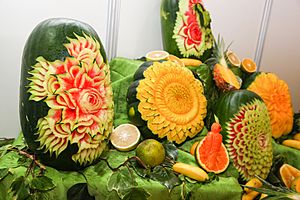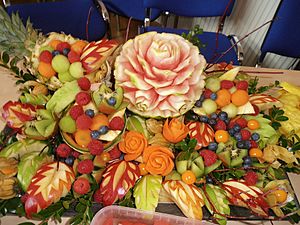Fruit carving facts for kids
Fruit carving is a special art form. It means shaping fruits into beautiful designs. This art is very popular in countries like Thailand, China, and Japan. But you can find it in Europe and other parts of Asia too!
Many different fruits can be carved. Some of the most popular choices are watermelons, apples, strawberries, pineapples, and cantaloupes. Artists use these fruits to create amazing sculptures.
Contents
The History of Fruit Carving
When Did Fruit Carving Begin?
Many people think fruit carving started in China. This was during the Tang Dynasty, a long time ago (from AD 618 to 906).
Fruit Carving in China
In China, fruit carvings often show legendary creatures and animals. People use these carvings for special cultural events and traditions. Even regular families might decorate their plates with carved fruit when guests visit.
Watermelon carving is very popular in China. Artists often carve the outside of the melon. Then, they scoop out the inside. The melon shell can then be used as a container for food or flowers. Chinese fruit carving helps tell old legends and stories.
Fruit Carving in Europe
Fruit carving was mentioned in a book from 1621 in Europe. This book, called Il Trinciante (meaning "The Carver"), described carving oranges and citrons. The designs included abstract shapes, shellfish, animals, and even a double-headed eagle. However, this art form did not become common in Europe or North America until the 1980s. That's when more books about fruit carving were published.
The Art of Thai Fruit Carving
Fruit carving is a very important part of Thai culture. Watermelon carving has been around in Thailand since the 14th century. This was during the Sukhothai dynasty.
Every November, Thailand celebrates the Loi Krathong Festival. During this festival, people float lamps and lanterns down rivers. This is to honor water spirits. One story says that a king's maid carved a watermelon with flower designs. She used it to decorate her lantern to impress the king. He was so happy that he encouraged all Thai women to learn fruit carving. The king even asked for fruit carving to be taught in primary schools! Thai fruit carvings often feature beautiful flowers, birds, and other natural patterns.
Japanese Mukimono Carving
In Japan, how a dish looks is very important. Fruit carving in Japan is called Mukimono. This art started in ancient Japan. Back then, food was served on rough, unglazed pottery plates. Chefs wanted to make the dishes look nicer. So, they would cover the plates with leaves. They folded the leaves into different designs.
Over time, this technique changed. Chefs started carving fruit to put on the plates. This made the dishes look even better. At first, street vendors would add carved fruit only if a customer asked for it. Now, it is very common for many Japanese dishes to have carved fruits. Learning fruit carving and garnishing is now a key part of training to become a Japanese chef.
How Fruit Carving is Done
Fruit carving uses many different tools. Some are everyday items, while others are made just for carving fruit. Each tool helps create a different texture or design.
Here are some common tools:
- Pen: Used to draw the design on the fruit before carving.
- Carving Knife: This is the most common tool. It helps give the carving its main shape.
- Peel Zester: This tool makes thin strips and grooves in the fruit's skin.
- Melon Baller: Used to scoop out small, round balls of fruit. These can be added to the display.
- U-shaped Garnish Tool: This tool cuts the outer layer of the fruit. It is great for fine, detailed work. Many carvers use it to make flower petals.
- V-shaped Formed Cutter: Similar to the U-shaped tool, but used for larger carving ideas.
Steps for Carving Fruit
Before you start carving, you need to gather all your tools. It's helpful to have them ready for each step. There are two main types of fruit carving:
- Skin Carving: This is when you carve only the outer skin of the fruit. You remove parts of the skin to show the different colored flesh underneath. The contrast between the skin and the fruit's inside creates the design.
- Three-Dimensional Carving: In this type, you carve the fruit into a 3D object. Floral designs are very popular for this.
It's easy to carve too much of a fruit. This can make it lose some of its nutrients. Always start by outlining your design on the fruit. Some designs are quick to make, while others need more time and focus. Each design is unique!
An important part of fruit carving is choosing the right fruit for how you will display it. Most fruit carvings need to be kept cool in a refrigerator before they are shown.
Fruit Carving Today
Many people today carve fruit as a profession. Some chefs use fruit carving as a special cooking technique. Once carvers become very skilled, they can offer their services to restaurants, hotels, and event planners.
Professional fruit carvers can create amazing centerpieces and displays. These are perfect for parties, weddings, and other events. Even on a smaller scale, fruit carvers can make a dish look extra special with decorative garnishes. This makes the food more appealing to everyone who sees it.




